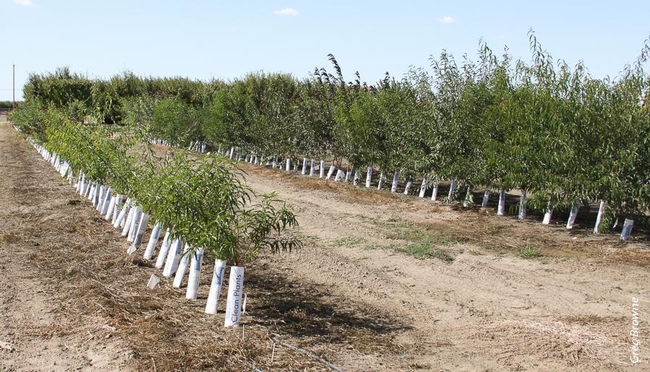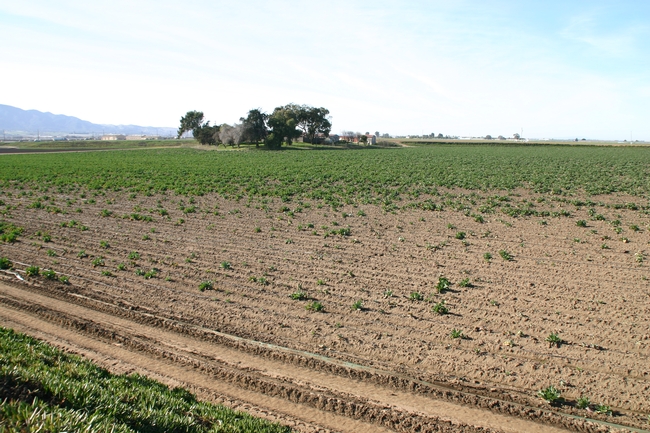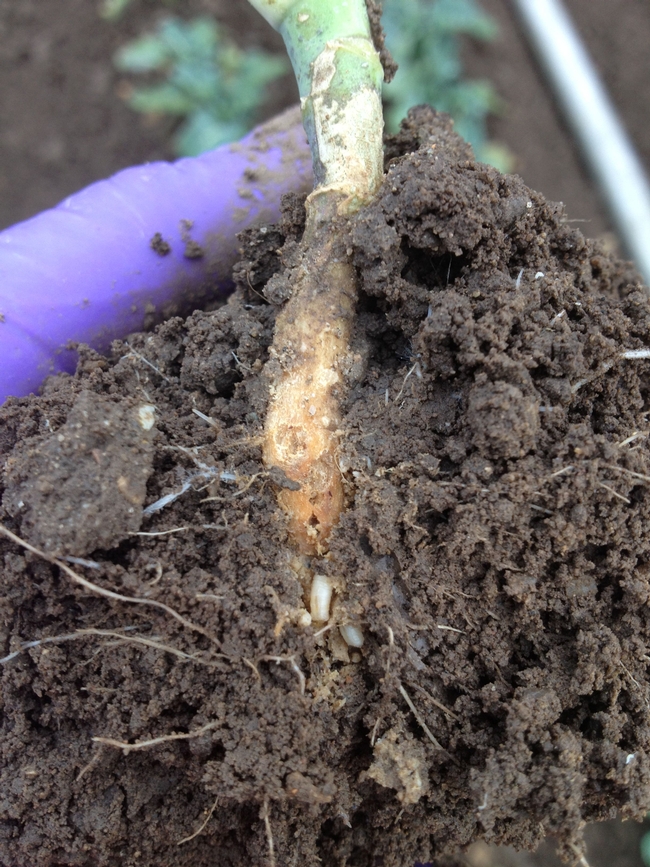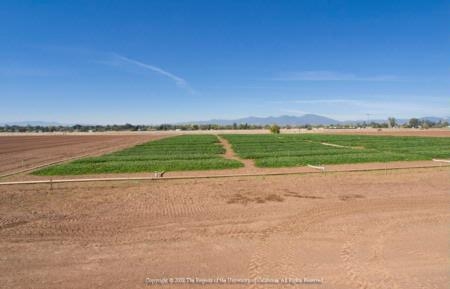Posts Tagged: methyl bromide
UC researchers help growers find alternatives to methyl bromide
A special collection of original research on methyl bromide alternatives is part of the July–September 2013 issue of California Agriculture, UC's peer-reviewed journal of agricultural, natural and human resources (http://californiaagriculture.ucanr.edu). Related articles will appear in the October–December 2013 issue.
Methyl bromide contributes to ozone depletion high in the atmosphere and was banned by developed countries in 2005 under the Montreal Protocol, an international treaty to protect the stratospheric ozone layer. Since then, the treaty has allowed limited use of methyl bromide for certain crops, but many of these exemptions are gone and the rest will end soon.
To develop and evaluate alternatives to methyl bromide, a team of UC and U.S. Department of Agriculture researchers was awarded a $5 million, five-year USDA grant. The project — called the Pacific Area-Wide Pest Management Program for Integrated Methyl Bromide Alternatives (PAW-MBA) — includes production crops such as grapes, strawberries and tree nuts as well as nursery crops such as cut flowers, forest trees and sweet potatoes.
"One goal of the program was to identify methyl bromide alternatives that were immediately useful and economically feasible," says Greg Browne, a USDA plant pathologist at UC Davis who coordinates the PAW-MBA program. "Another was to foster development of nonfumigant strategies for managing soilborne pests."
The team has identified methyl bromide alternatives that are both effective and economical for key California crops. When the best alternative is another fumigant, the researchers found ways to use less and to cut emissions. In addition, the researchers are developing alternatives that go beyond fumigants, including steam sterilization and other nontoxic approaches.
Summaries of projects and links to articles:
TIF film, substrates and nonfumigant soil disinfestation maintain fruit yields
Strawberry growers use methyl bromide primarily to control soilborne diseases. Now, new UC research shows that this crop can be grown without fumigants at small scales. Three nontoxic methods — nonsoil substrates, anaerobic soil disinfestation and steam disinfestation — produced strawberry yields as high as those in conventionally fumigated soil. “Instead of understanding soil, we've just been fumigating it," says Steve Fennimore, a UC Cooperative Extension specialist in Salinas who led this team. "Using physical tools is a different approach." Researchers will next evaluate whether these alternative methods can be scaled up to commercial production fields, and whether they work in different strawberry production areas of California.
Managing the almond and stone fruit replant disease complex with less soil fumigant
Almond and stone fruit growers need methyl bromide alternatives to control nematodes and Prunus replant disease, a soilborne disorder that stunts new orchards and cuts yields. To help these growers, UC and USDA researchers tested alternative fumigants, spot and strip fumigation and nonfumigant methods including rotating orchards with sudangrass and using nematode-resistant rootstock. “Spot treatments provided adequate control of Prunus replant disease and may be very helpful to growers needing to use less fumigant for costs savings or regulatory restrictions,” Browne says. In addition, integrating the various treatments tested may also help control the replant disease with less fumigant use.
Preplant 1,3-D treatments test well for perennial crop nurseries, but challenges remain
California supplies nursery stock to the state's fruit, nut and vineyard industries, as well as more than 60 percent of the rose plants and fruit and nut trees sold nationwide. This perennial nursery stock must be completely nematode-free, and growers use methyl bromide primarily to control these tiny soilborne worms. However, alternative fumigants such as 1,3-dichloropropene (1,3-D) don't work as well in fine soils. "We asked how we could make them work better," says Brad Hanson, a UC Cooperative Extension specialist in the Department of Plant Sciences at UC Davis. The researchers showed that 1,3-D controlled nematodes in fine soil when they tilled it deeper, injected the fumigant deeper and used tarps that kept more of the fumigant in the soil.
Fumigant emission reductions with TIF warrant regulatory changes
Fumigants are regulated partly because they help make smog. Totally impermeable film (TIF) can help keep fumigants in the soil and out of the air. New UC research shows that fumigant emissions can drop 64 percent when fields are tarped with TIF for twice as long as usual (10 days instead of 5). "We're now working on safe use," says Suduan Gao, a USDA soil scientist in Parlier who led the team. "The goal is to keep the fumigant under the tarp long enough that there won't be a surge in emissions when it's cut open." This work gives regulatory agencies a new way to let growers keep using enough fumigant to control pests and diseases while minimizing the smog-forming emissions.
The entire July–September 2013 issue can be downloaded at http://californiaagriculture.ucanr.edu.
California Agriculture is the University of California's peer-reviewed journal of research in agricultural, human and natural resources. For a free subscription, go to: http://californiaagriculture.ucanr.edu, or write to calag@ucanr.edu.
The University of California's Division of Agriculture and Natural Resources is the bridge between local issues and the power of UC research. UC ANR's advisors, specialists and faculty bring practical, science-based answers to Californians. Visit http://ucanr.edu to learn more.
WRITERS/EDITORS: To request a hard copy of the journal, email crllopez@ucanr.edu.
UC ANR scientists get $450,000 to study pesticide alternatives
UC ANR scientists get $450,000 to study pesticide alternatives
Two scientists in University of California Agriculture and Natural Resources have received grants from the California Department of Pesticide Regulation for research to improve crop yields and reduce the risks associated with pesticide use in California.
The root maggot, a pest of cole crops, can wipe out an entire field of broccoli or cauliflower by tunneling through the plants’ roots. With a new $302,542 grant from the Department of Pesticide Regulation, Shimat Joseph, UC Cooperative Extension advisor in Monterey County, will study ways growers can protect their high-value crops from this persistent pest.
“In the Salinas Valley, cabbage maggot infestation in a field can exceed 90 percent,” said Joseph, who specializes in integrated pest management.
To control the maggots, growers usually apply organophosphate insecticides, such as chlorpyrifos and diazinon, to the soil, but those chemicals don’t kill all of the destructive insects and may contaminate waterways. In hopes of finding more sustainable control methods, Joseph will study preventive tactics including multicropping, planting less-susceptible cultivars, changing cultural practices and using lower-risk pesticides.
Joseph, who specializes in entomology, will evaluate the susceptibility of broccoli when it is planted next to other various crops such as turnip, lettuce, cauliflower or cabbage, to see if the neighboring crop influences the broccoli field’s attractiveness to cabbage maggots. He will also evaluate different broccoli and cauliflower varieties for their resistance or tolerance to the maggots and will look into the role planting date in determining a plant’s susceptibility to the pest.
Lynn Epstein, professor in the Department of Plant Pathology at UC Davis, received a $153,289 Department of Pesticide Regulation grant to study alternatives to methyl bromide for strawberry nursery fumigation.
California produces more than a billion strawberry runner plants every year, with a total annual value of approximately $60 million. For the past 50 years, fumigating the soil with methyl bromide before planting has been the most effective way to keep soil-borne pathogens, nematodes and weeds from overwhelming strawberry nursery plants. In recent years, though, methyl bromide has become increasingly restricted, with the intention of eventually phasing it out entirely.
Anaerobic soil disinfestation integrates heat from solarization and oxygen deprivation from flooding, according to Epstein.
“We’ll incorporate a relatively inexpensive carbon source into the topsoil, irrigate it to field capacity, and then cover the amended soil with a plastic tarp,” Epstein said. The anaerobic byproducts that build up are toxic to pathogens, but those byproducts will degrade rapidly after the tarp is removed.”
New film traps fumigants and increases strawberry yields
Producing 85 percent of the nation’s strawberries, California growers urgently need alternatives to methyl bromide fumigation if they are to maintain yields. Methyl bromide has been phased out for all but critical uses because it depletes ozone in the upper atmosphere.
UC scientists now report that use of totally impermeable film in strawberry fields can improve the effectiveness of a widely-used MB alternative known as 1,3-D (1,3, dichloropropene). Use of the film reduces the amount of 1,3-D needed to maintain yields, while lowering field emissions overall.
The strawberry industry is highly dependent on soil fumigation to control pests and maintain high yields. The methyl bromide alternative, 1,3-D, can be used only in certain quantities, due to air quality concerns.
In a recent trial, totally impermeable film (TIF) was laid out over Salinas fields to prevent the fumigant from leaking. The new film was compared with the standard film used by growers. Fumigant concentrations under TIF were 46 percent to 54 percent higher than under standard film, and the higher concentrations were correlated with higher strawberry yields and better weed control. Scientists report these findings in detail in the October–December 2011 electronic edition of the University of California’s California Agriculture journal.
Impermeable films have three benefits, according to lead author Steven Fennimore, UC Cooperative Extension specialist and weed scientist in UC Davis Department of Plant Sciences. The films trap the fumigant in the soil for a longer time and thereby increase its effectiveness; they reduce fumigant emissions, which after reacting with nitrogen oxides, can convert to ground-level ozone; and they reduce the amount of fumigant needed for effective pest control.
Emissions are a chief concern. Methyl bromide, a widely used fumigant in combination with chloropicrin, has been phased out since 2005 because it is an ozone-depleting substance targeted by the Montreal Protocol (a global treaty to control ozone depletion) and the U.S. Clean Air Act. However, it is still being used in some California strawberry fields under a critical-use exemption. Restrictions on the use of 1,3-D to 90,250 pounds per 36-square-mile township (called the township cap) leave few other options for growers in key strawberry production areas near densely populated areas.
Comparing TIF with standard film, and methyl bromide plus chloropicrin with varying amounts of 1,3-D plus chloropicrin, the scientists rated the effectiveness of TIF. The results, writes Fennimore, suggest that to achieve fruit yield and weed control similar to methyl bromide and chloropicrin, 33 percent less 1,3-D plus chloropicrin is needed under TIF than standard films.
TIF may ease some of the burdens of fumigant regulations on end-users, as well as ease concerns of the general public about exposure to fumigants, he concludes.
The entire October–December 2011 issue, and the electronic edition, can be viewed and downloaded at http://californiaagriculture.ucanr.org.
California Agriculture is the University of California’s peer-reviewed journal of research in agricultural, human and natural resources. For a free subscription, visit http://californiaagriculture.ucanr.org, or write to calag@ucdavis.edu.
###
WRITERS/EDITORS: To request a hard copy of the journal, email crllopez@ucdavis.edu





